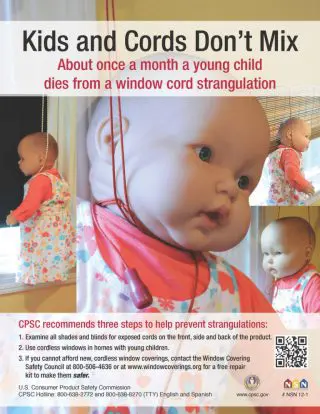 Being a consumer and personal Finance journalist has many rewards. However, the consumer safety part of it can be gut wrenching. Reading about how the intestines of kids can be sucked out by spa and swimming pool drains, how kids who slump over in an inclined sleeper can die from suffocation, and how kids can be crushed by dressers and TV is sickening.
Being a consumer and personal Finance journalist has many rewards. However, the consumer safety part of it can be gut wrenching. Reading about how the intestines of kids can be sucked out by spa and swimming pool drains, how kids who slump over in an inclined sleeper can die from suffocation, and how kids can be crushed by dressers and TV is sickening.
Then, there are window covering cords. See the photo at the left on how this occurs. I’ve been known to cut the loop made by cords of window coverings at the houses with toddlers.
Finally, after years of waiting and delays, the U.S. Consumer Product Safety Commission finalized two rules Wednesday to address unsafe accessible cords in both stock and custom window coverings.
Both new rules address the risk of strangulation that can cause serious injury and death to children 8 years old and younger from accessible cords of custom and stock window coverings.
One new mandatory rule addressing custom window coverings requires safety standards for the safe operation of custom products. It goes into effect 180 days after publication in the Federal Register.
The other new rule finalized Wednesday “deems the presence of hazardous operating cords and inner cords on stock window coverings and hazardous inner cords on custom window coverings to be a substantial product hazard.” This means that if a stock window covering has an unsafe operating and inner cord and a custom window covering has an unsafe inner cord, the CPSC can take action to protect consumers. This second rule goes into effect 30 days after publication in the Federal Register for window coverings manufactured after that date.
“It took 20 years to the day for this mandatory rule to finally happen,” Linda Kaiser, founder of Parents for Window Blind Safety, said in a statement.
Her daughter, Cheyenne, died from a cord that ran between the slats of a window blind in 2002.
“By the time we wrote the petition in 2013, over 100 children had been injured and killed,” Kaiser said. “The saddest thing for me is talking to a parent who lost a child on a product that was professionally installed or labeled child safe.”
Strangulation incidents can happen quickly even when parents are in the same room, she said, adding that due to vagus nerve compression during these incidents, the impact of injury is severe and the chance of survival after entanglement is less than one minute.
The Consumer Federation of America petitioned the CPSC in 2014 because of the failure of the voluntary standard to adequately address the hazard posed by accessible window covering cords, said Rachel Weintraub, legislative director and general counsel with the federation, an association of consumer groups.
“In the last eight years, that failure has only become starker, and the need for a mandatory standard has become even more necessary,” Weintraub said.
Carol Pollack-Nelson, Ph.D., a psychologist and owner of Independent Safety Consulting, said it saddens her that the industry didn’t step up sooner, and on its own, despite decades of infant and child fatalities.
“As a result,” Pollack-Nelson said, “there will undoubtedly continue to be strangulation deaths on corded products already in consumers’ homes for many years to come.”
The CPSC urges consumers to choose cordless window coverings, which are the safest option for children. For more information, visit CPSC’s Window Covering Safety Education Center.
Originally Published on https://boomersurvive-thriveguide.typepad.com/the_survive_and_thrive_bo/
Notifications